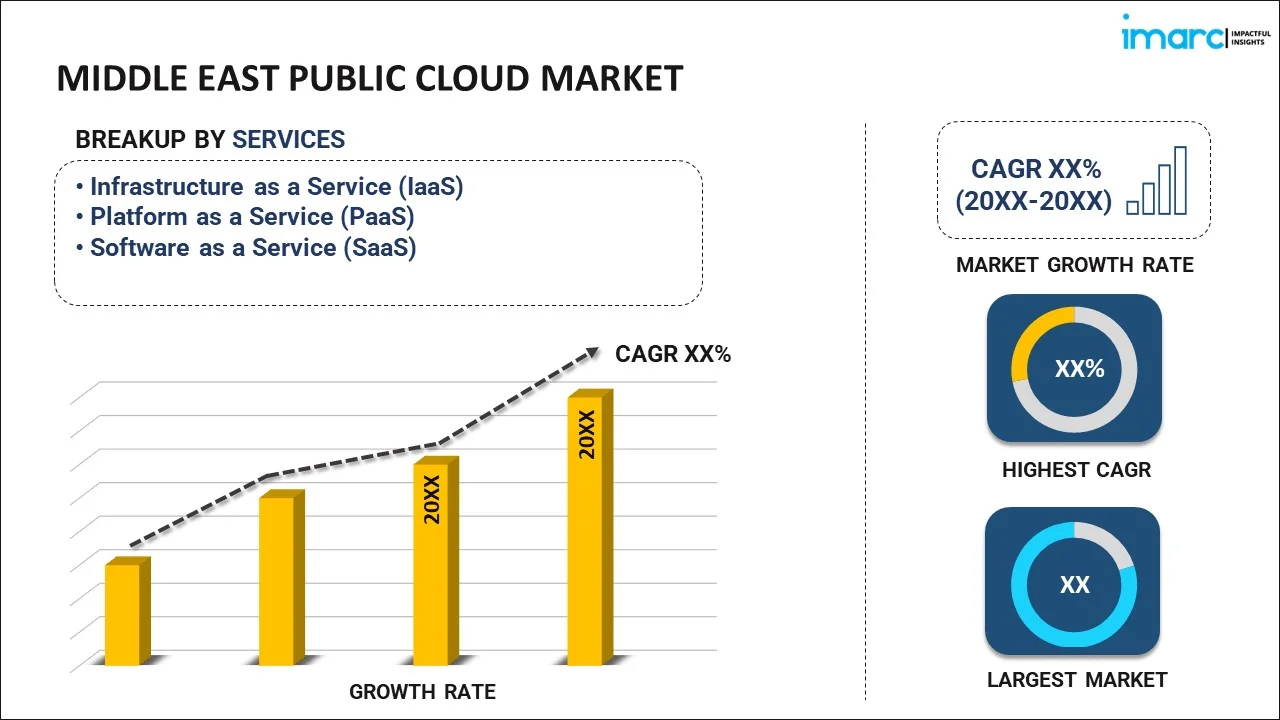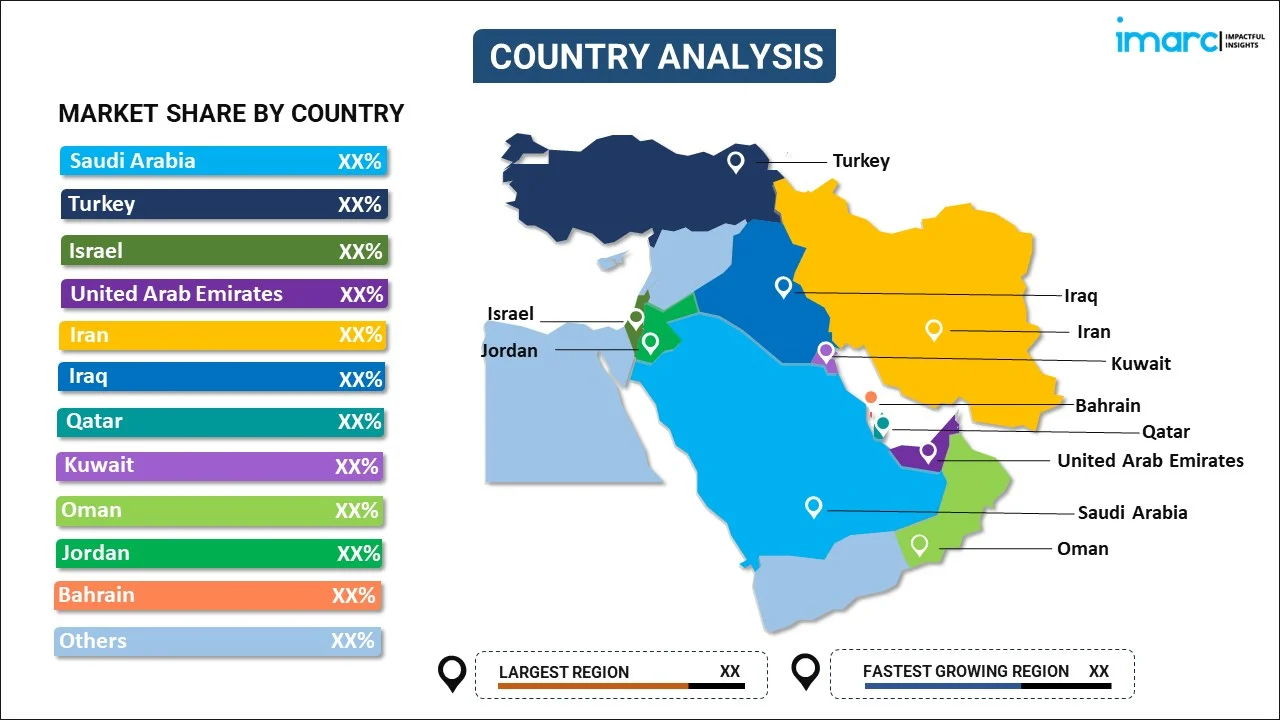
Middle East Public Cloud Market Report by Service (Infrastructure as a Service (IaaS), Platform as a Service (PaaS), Software as a Service (SaaS)), Enterprise Size (Large Enterprises, Small and Medium-sized Enterprises), End Use (BFSI, IT and Telecom, Retail and Consumer Goods, Manufacturing, Energy and Utilities, Healthcare, Media and Entertainment, Government and Public Sector, and Others), and Country 2025-2033
Market Overview:
Middle East public cloud market size is projected to exhibit a growth rate (CAGR) of 19.86% during 2025-2033. The growing demand for specialized platforms that enable organizations to collect, store, analyze, and act upon data from IoT devices effectively is primarily driving the market growth across the country.
|
Report Attribute
|
Key Statistics
|
|---|---|
|
Base Year
|
2024 |
|
Forecast Years
|
2025-2033
|
|
Historical Years
|
2019-2024
|
| Market Growth Rate (2025-2033) | 19.86% |
The public cloud refers to a form of computing service provided by external providers, wherein resources like servers, storage, and networking capabilities are delivered over the internet. These services typically follow a pay-as-you-go pricing model, allowing businesses to adjust their infrastructure in response to demand without significant upfront capital investment. Major public cloud platforms, including Amazon Web Services (AWS), Google Cloud Platform (GCP), and Microsoft Azure, offer a broad spectrum of services ranging from basic computing resources to advanced tools like machine learning and analytics. This technology empowers organizations to attain increased scalability, flexibility, and operational efficiency, freeing them to concentrate on core business activities rather than managing intricate IT infrastructure. Nonetheless, effective usage demands vigilant oversight of security and privacy considerations, given that data is stored on shared resources beyond the direct control of the organization.
Middle East Public Cloud Market Trends:
The Middle East public cloud market is experiencing a noteworthy surge, underscoring the region's embrace of advanced computing solutions and digital transformation. These services offer a diverse range of computing resources, storage options, and networking capabilities, fostering scalability and flexibility for businesses across various sectors, which is acting as another significant growth-inducing factor. Moreover, the pay-as-you-go pricing model prevalent in the public cloud allows organizations to dynamically adjust their infrastructure according to demand without hefty upfront investments, aligning well with the region's evolving business models. This, in turn, is positively influencing the regional market. Additionally, as Middle Eastern businesses increasingly leverage public cloud platforms, they gain access to a spectrum of advanced tools, including machine learning, analytics, and other innovative services that enhance efficiency and innovation. Apart from this, the adoption of public cloud services allows organizations in the Middle East to concentrate on their core competencies while outsourcing complex IT infrastructure management to reliable cloud providers, which is projected to fuel the regional market over the forecasted period.
Middle East Public Cloud Market Segmentation:
IMARC Group provides an analysis of the key trends in each segment of the market, along with forecasts at the regional and country levels for 2025-2033. Our report has categorized the market based on service, enterprise size, and end use.
Service Insights:

- Infrastructure as a Service (IaaS)
- Platform as a Service (PaaS)
- Software as a Service (SaaS)
The report has provided a detailed breakup and analysis of the market based on the service. This includes infrastructure as a service (IaaS), platform as a service (PaaS), and software as a service (SaaS).
Enterprise Size Insights:
- Large Enterprises
- Small and Medium-sized Enterprises
A detailed breakup and analysis of the market based on the enterprise size have also been provided in the report. This includes large enterprises and small and medium-sized enterprises.
End Use Insights:
- BFSI
- IT and Telecom
- Retail and Consumer Goods
- Manufacturing
- Energy and Utilities
- Healthcare
- Media and Entertainment
- Government and Public Sector
- Others
The report has provided a detailed breakup and analysis of the market based on the end use. This includes BFSI, IT and telecom, retail and consumer goods, manufacturing, energy and utilities, healthcare, media and entertainment, government and public sector, and others.
Country Insights:

- Saudi Arabia
- Turkey
- Israel
- United Arab Emirates
- Iran
- Iraq
- Qatar
- Kuwait
- Oman
- Jordan
- Bahrain
- Others
The report has also provided a comprehensive analysis of all the major regional markets, which include Saudi Arabia, Turkey, Israel, United Arab Emirates, Iran, Iraq, Qatar, Kuwait, Oman, Jordan, Bahrain, and Others.
Competitive Landscape:
The market research report has also provided a comprehensive analysis of the competitive landscape. Competitive analysis such as market structure, key player positioning, top winning strategies, competitive dashboard, and company evaluation quadrant has been covered in the report. Also, detailed profiles of all major companies have been provided.
Middle East Public Cloud Market Report Coverage:
| Report Features | Details |
|---|---|
| Base Year of the Analysis | 2024 |
| Historical Period | 2019-2024 |
| Forecast Period | 2025-2033 |
| Units | Million USD |
| Scope of the Report | Exploration of Historical and Forecast Trends, Industry Catalysts and Challenges, Segment-Wise Historical and Predictive Market Assessment:
|
| Services Covered | Infrastructure as a Service (IaaS), Platform as a Service (PaaS), Software as a Service (SaaS) |
| Enterprise Sizes Covered | Large Enterprises, Small and Medium-sized Enterprises |
| End Uses Covered | BFSI, IT and Telecom, Retail and Consumer Goods, Manufacturing, Energy and Utilities, Healthcare, Media and Entertainment, Government and Public Sector, Others |
| Countries Covered | Saudi Arabia, Turkey, Israel, United Arab Emirates, Iran, Iraq, Qatar, Kuwait, Oman, Jordan, Bahrain, Others |
| Customization Scope | 10% Free Customization |
| Post-Sale Analyst Support | 10-12 Weeks |
| Delivery Format | PDF and Excel through Email (We can also provide the editable version of the report in PPT/Word format on special request) |
Key Questions Answered in This Report:
- How has the Middle East public cloud market performed so far and how will it perform in the coming years?
- What has been the impact of COVID-19 on the Middle East public cloud market?
- What is the breakup of the Middle East public cloud market on the basis of service?
- What is the breakup of the Middle East public cloud market on the basis of enterprise size?
- What is the breakup of the Middle East public cloud market on the basis of end use?
- What are the various stages in the value chain of the Middle East public cloud market?
- What are the key driving factors and challenges in the Middle East public cloud?
- What is the structure of the Middle East public cloud market and who are the key players?
- What is the degree of competition in the Middle East public cloud market?
Key Benefits for Stakeholders:
- IMARC’s industry report offers a comprehensive quantitative analysis of various market segments, historical and current market trends, market forecasts, and dynamics of the Middle East public cloud market from 2019-2033.
- The research report provides the latest information on the market drivers, challenges, and opportunities in the Middle East public cloud market.
- Porter's five forces analysis assist stakeholders in assessing the impact of new entrants, competitive rivalry, supplier power, buyer power, and the threat of substitution. It helps stakeholders to analyze the level of competition within the Middle East public cloud industry and its attractiveness.
- Competitive landscape allows stakeholders to understand their competitive environment and provides an insight into the current positions of key players in the market.
Need more help?
- Speak to our experienced analysts for insights on the current market scenarios.
- Include additional segments and countries to customize the report as per your requirement.
- Gain an unparalleled competitive advantage in your domain by understanding how to utilize the report and positively impacting your operations and revenue.
- For further assistance, please connect with our analysts.
 Inquire Before Buying
Inquire Before Buying
 Speak to an Analyst
Speak to an Analyst
 Request Brochure
Request Brochure
 Request Customization
Request Customization




.webp)




.webp)












